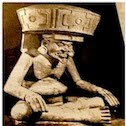 |
| An ISIG is a wide glyph set over two columns of text on stone stelae: Unknown Entity. Drawn by Carolyn Jones as the ISIG for a resource booklet at the Maya Meeting , 2002, at UT at Austin Texas |
At first I believed that above ISIG to be the same as the Square-Nosed Beastie found in the Nuttall Codice, but closer inspection of the ISIG at the beginning of this post and the double panel shown below of the east side of Stela -F proved me wrong.
 |
| Nuttall Codex: N-17-MM The End of the "Star-Eating" Cycle Date is 10- Crocodile |
Such as the double set below is found on the east side of Stela-F at Quirigua. The ISIG at the top or columns A-B does not have the same iconography as the large version above.
 |
| Stela -F East side with ISIG using the Square-Nosed Beastie. Drawn by Matthew Looper, author of Lightning Warrior (2003) |
 |
| Stela F-East side ISIG: Square -Nosed Beastie |
I have long believed that it was a statement giving the regal power to K'ak Tiliw Yoaat, but when Simon Martin and Nikolai Grube compiled the Chronicle of the Maya Kings and Queens in 2000, it became clear that the stela was a sign indicated for the event of the Square-Nosed. Beastie, Eater of the Stars as found in the Nuttall Codex in the Mixtec area.
 |
| Stela F Ka'k Tiliw Chan Yoaat Or "Fire-Burning Sky Lightning God" |
 |
| Stela K: K'ak' jo-[lo]-ya Chan-na yo-Yoat:T? ti Or "Jade Sky" |
Stela F contains a story about the Square-Nosed Beastie also known as the Star-Eater of the sky ball court i.e.: the Milky Way.
There are dates in this story but they have been skewed to trillions of years in the past.
Unless there is a major correction to the dates, the story cannot be a true source of "power" for any ruler in Quirigua. Mostly because no human existed in that a very long time ago. There was no one to carry the memory forward into Maya times.
If the Square-Nosed Beastie is (or was) such a strong power source in Quirigua, that in 624 AD was used to introduce the son of Pacal as "he who would inherit Pacal's rule." one year after the death of Ruler 14 in Copan.
It is strange that the Square-Nosed Beastie is so prominent on the tomb of Pacal as the same Tree of Creation, [the Milky Way]---when Pacal introduced his son as the next ruler for the throne when he would die; it makes one wonder why the Square-Nosed Beastie has been ignored for so long. H.m.m.m.m. Not at Palenque? Look again.
 |
| The Temple of the Cross and the Sarcophagus of Pacal |
 |
| Justin Kerr: K-688£ |
Is this bird the death of the Square-Nosed Beastie? It appears to be the last square-breath of a decapitated flying entity with a smoking tail: a tail that spewed enough smoke and dust into the the stars of the Milky Way that are still hidden in a narrow space that gives appearance of a pathway for bees to go up into the most beautiful rose (now called a Camilla by NASA).
The beautiful rose is that of the Ring Nebula. once a blazing blue star before the Great Tree of Creation broke into two pieces. The broken piece is called the Tree of the Warrior (Orion is inferred).
That story can be seen in the March 23, 2013 blog here.
.




